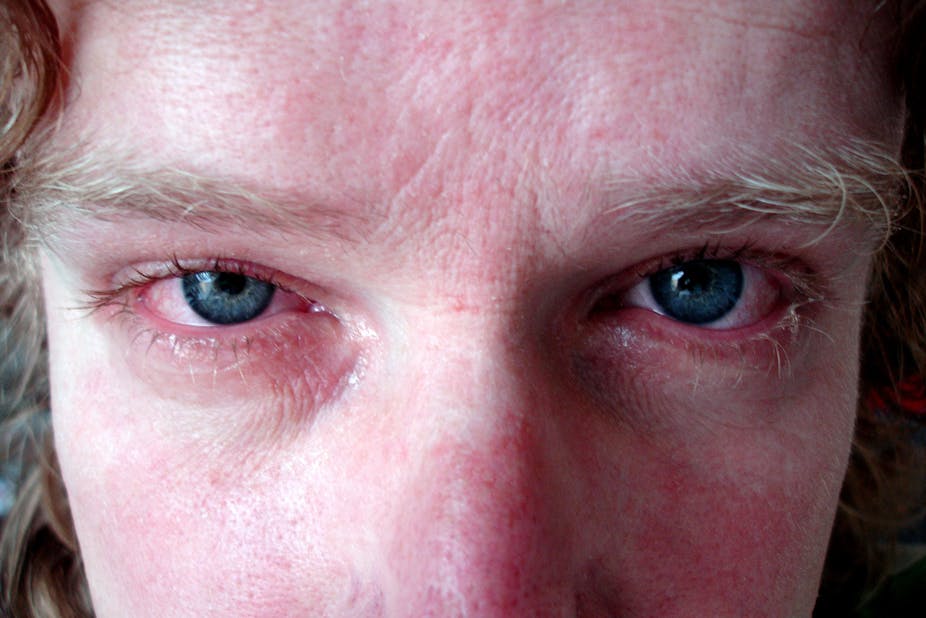Spring and summer are accompanied for many with the much less welcome start of another bout of “hayfever”. A term originating in England, “hayfever” arose out of the popular belief that the ailment was caused by some invisible emanation from new hay.
Today, seasonal allergic rhinoconjunctivitis (or pollinosis in Europe) is one of the most common chronic respiratory conditions seen in medical practice.
According to a recent Australian Institute of Health & Welfare (AIHW) report, around 15% of Australians or 3.1 million people report suffering from the condition. And the amount of money paid by community pharmacies to wholesalers for medications commonly used to treat allergic rhinitis doubled between 2001 ($107.8 million) and 2010 ($226.8 million).
Whence the symptoms?
Symptoms of allergic rhinoconjunctivitis are caused by an allergic reaction resulting in inflammation of the nasal lining. This leads to other consequences.
The first step in an allergic reaction is the development of sensitisation. Repeated exposure to an allergen in a genetically predisposed individual leads to the formation of an allergic antibody (IgE) response to that particular allergen. Once sensitised, exposure to small amounts of the allergen can cause a rapid response, leading to the development of a range of symptoms.

Typical symptoms include itching of the nose, ears, palate, repeated sneezing, watery nasal discharge, nasal congestion or blockage, and, for many, these symptoms are accompanied by itchy, watery, red eyes.
Blame the plants
At this time of the year, the most common trigger for allergic rhinoconjunctivitis is pollen exposure. Pollen is the male gamete produced by all flowering plants to fertilise the female part of the flower.
Many factors affect the pollen load in the air: time of year, density of plant species, temperature, rainfall, humidity, wind and its direction, and hours of sunlight. Most hayfever sufferers are sensitive to many different pollen species but wind-pollinated plants, such as grasses, are the most significant triggers.
People often blame more obvious plants, such as wattle or Plane trees, for their reaction but these aren’t the most common causes of allergic rhinoconjunctivitis.
Misunderstood burden
The symptoms of allergic rhinoconjunctivitis are very annoying to those who suffer them but the true burden of this condition is often underestimated.
We classify severity of allergic rhinoconjunctivitis as mild or moderate/severe. With mild allergic rhinitis, there’s no impairment of sleep, daily activities, leisure or sport, and school or work. That’s because while symptoms are present, they aren’t troublesome.

With moderate/severe allergic rhinoconjunctivitis, there may be impairment of sleep, daily activities, leisure or sport and impairment of school or work. Since this level of impairment occurs at peak exam time for many teenagers and young adults, there’s clearly potential for significant interference with life.
Hayfever companions
Allergic rhinoconjunctivitis is associated with a number of other chronic conditions (co-morbidities), the most important of which is asthma. These two conditions share common genetic factors and triggers. About four out of five people with asthma have rhinitis and between 15% and 30% of rhinitis patients have asthma.
Other associated conditions include middle ear infection, sinusitis and sleep apnoea.
There’s no cure for allergic rhinitis so effective management is the best available approach and the goal is to achieve optimal symptom control. Patients who seek advice and guidance from their GP or specialist have a better outcome with management than those who continually self medicate.
Other therapies
Therapeutic options include allergen avoidance, pharmacotherapy (such as intranasal corticosteroids and antihistamines), non-medicated treatments (such as saline douches or sprays) and immunotherapy, either injection or sublingual therapy.

Patients are always interested in ways of avoiding their triggers but where pollen is concerned, truly useful avoidance strategies are limited. You can stay indoors with air conditioning and filtration systems in place, but this isn’t very practical advice.
Certainly wearing sunglasses and a hat while outdoors may minimise the eye symptoms as pollen grains won’t be able to come into contact with the membrane that covers the eye and lines the inside of the eyelids (conjunctiva).
Over-the-counter meds
Many “hayfever treatments” are available over the counter at the pharmacy so most people try these before seeking help. Antihistamines may address some of the symptoms associated with the condition – they can relieve itching, sneezing and the runny nose – but are less effective at clearing nasal blockage.
Ideally only non-sedating antihistamines should be used because even though they’re cheaper, other types may have a negative impact on performance and concentration. But antihistamines only treat the symptoms, not addressing the underlying allergic inflammation that’s the basis of the problem.
Ideal management involves using a treatment that’ll reduce allergic inflammation and have a greater lasting effect on all aspects of the condition. Intranasal corticosteroids fulfil this role, with the newer agents having an excellent safety profile. They’re preventative medication and ideally should be used from the onset of the pollen season to ensure maximum benefit.

Compliance with correct use may be a problem so seeking medical advice and understanding the way they work and their safety profile, will lead to better outcomes.
Oldie but goodie
Immunotherapy is a very old therapy. In fact, this type of treatment celebrates a 100 years of use this year! Following decades of active research, we have a much better understanding of how immunotherapy brings about reduction in allergic inflammation and leads to long-term benefit for people with allergic rhinoconjunctivitis.
This is a long-term treatment requiring dedication, compliance and some expense so it must be prescribed by a specialist who’ll advise on suitability and provide the vaccine prescription.
Seasonal allergic rhinoconjunctivitis is usually a long-lived condition once it’s triggered, affecting older children, teenagers and adults, sometimes for decades. It causes significant impairment of quality of life and is often associated with other conditions.
Although there’s no cure at present, it can be successfully managed so seek advice from your GP and in some instances, from an allergy specialist, so that the management strategy that’s best for your condition may be formulated.

